Table of Contents
Circles are provided here in PDF format, which can be downloaded for free. The NCERT Exemplar Solutions for this chapter Circles is included for the second term as per the latest update of the term-wise CBSE curriculum (2021-22) and has been designed by our expert teachers with 100 percent accuracy.
All the solved questions of Chapter 10 Circles, are with respect to the second term CBSE syllabus and guidelines, to help students solve each exercise question present in the book and prepare for the exam. These serve as reference tools for the students to do homework and also support them to score good marks. Students can also get the solutions for Class 9th Maths all chapters exercise-wise and practice well for the second term exams.
Chapter 10, Circles, of Grade 9, is one of the most important chapters, whose concepts will also be used in Class 10. The weightage of this chapter in the final exam is around 15 marks. Therefore, students are advised to read the chapter carefully and practice each and every question included in the textbook with the help of NCERT Exemplar Solutions along with examples, to have good practice.
NCERT Exemplar Solutions for Class 9 Maths Chapter 10 Circles – Infinity Learn
Key Features of NCERT Exemplar Solutions for Class 9 Maths Chapter 10- Circles
- The solutions for the chapter-Circles work as a reference for the students.
- Students will be able to resolve all the problems of this chapter in a faster way.
- It is good learning material for exam preparation and to do the revision for Class 9 Maths Chapter 10.
- The questions of Circles are solved by our subject experts.
- The NCERT Exemplar Solutions are given as per the latest update on the CBSE syllabus and guidelines.
NCERT Exemplar Class 9 Maths Chapter 5 Exercise 5.1
Question 1.
The three steps from solids to points are:
(A) Solids-surfaces-lines-points
(B) Solids-lines-surfaces-points
(C) Lines-points-sucfaces-solids
(D) Lines-surfaces-points-solids
Solution:
(A): The three steps from solids to points are solids-surfaces-lines-points.
Question 2.
The number of dimensions, a solid has:
(A) 1
(B) 2
(C) 3
(D) 0
Solution:
(C): A solid e.g., Cuboid has shape, size, and position. So, solid has three dimensions.
Question 3.
The number of dimensions, a surface has:
(A) 1
(B) 2
(C) 3
(D) 0
Solution:
(B): Boundaries of a solid are called surfaces. A surface (plane) has only length and breadth. So, it has two dimensions.
Question 4.
The number of dimension, a point has
(A) 0
(B) 1
(C) 2
(D) 3
Solution:
(A): A point is that which has no part
i. e., no length, no breadth and no height. So, it has no dimension.
Question 5.
Euclid divided his famous treatise “The Elements” into
(A) 13 chapters
(B) 12 chapters
(C) 11 chapters
(D) 9 chapters
Solution:
(A): Euclid divided his famous treatise ‘The Elements” into 13 chapters.
Question 6.
The total number of propositions in the Elements are
(A) 465
(B) 460
(C) 13
(D) 55
Solution:
(A): The statements that can be proved are called propositions or theorems. Euclid deduced 465 propositions in a logical chain using his axioms, postulates, definitions and theorems.
Question 7.
Boundaries of solids are:
(A) surfaces
(B) curves
(C) lines
(D) points
Solution:
(A): Boundaries of solids are surfaces.
Question 8.
Boundaries of surfaces are:
(A) surfaces
(B) curves
(C) lines
(D) points
Solution:
(B) : The boundaries of surfaces are curves.
Question 9.
In Indus Valley Civilisation (about 3000 B.C.), the bricks used for construction work were having dimensions in the ratio
(A) 1 : 3 : 4
(B) 4 : 2 : 1
(C) 4 : 4 : 1
(D) 4 : 3 : 2
Solution:
(B) : In Indus Valley Civilisation, the bricks used for construction work were having dimensions in the ratio length : breadth : thickness = 4 : 2 : 1.
Question 10.
A pyramid is a solid figure, the base of which is
(A) only a triangle
(B) only a square
(C) only a rectangle
(D) any polygon
Solution:
(D) : A pyramid is a solid figure, the base of which is a triangle or square or some other polygon.
Question 11.
The side faces of a pyramid are
(A) Triangles
(B) Squares
(C) Polygons
(D) Trapeziums
Solution:
(A) : The side faces of a pyramid are always triangles.
Question 12.
It is known that, if x + y = 10, then x + y + z = 10 + z. The Euclid’s axiom that illustrates this statement is:
(A) First Axiom
(B) Second Axiom
(C) Third Axiom
(D) Fourth Axiom
Solution:
The Euclid’s axiom that illustrates the given statement is second axiom. According to this, if equals are added to equals, the wholes are equal.
Question 13.
In ancient India, the shapes of altars used for household rituals were:
(A) Squares and circles
(B) Triangles and rectangles
(C) Trapeziums and pyramids
(D) Rectangles and squares
Solution:
(A) : In ancient India, squares and circular altars were used for household rituals.
Question 14.
The number of interwoven isosceles triangles in Sriyantra (in the Atharvaveda) is:
(A) Seven
(B) Eight
(C) Nine
(D) Eleven
Solution:
(C): The Sriyantra (in the Atharvaveda) consists of nine interwoven isosceles triangles.
Question 15.
Greek’s emphasised on:
(A) Inductive reasoning
(B) Deductive reasoning
(C) Both (A) and (B)
(D) Practical use of geometry
Solution:
(B) : Greek’s emphasised on deductive reasoning.
Question 16.
In ancient India, altars with combination of shapes like rectangles, triangles and trapeziums were used for
(A) Public worship
(B) Household rituals
(C) Both (A) and (B)
(D) None of A, B, C
Solution:
(A): In ancient India altars whose shapes were combinations of rectangles, triangles and trapeziums were used for public worship.
Question 17.
Euclid belongs to the country:
(A) Babylonia
(B) Egypt
(C) Greece
(D) India
Solution:
(C) : Euclid belongs to the country Greece.
Question 18.
Thales belongs to the country:
(A) Babylonia
(B) Egypt
(C) Greece
(D) Rome
Solution:
(C) : Thales belongs to the country Greece.
Question 19.
Pythagoras was a student of:
(A) Thales
(B) Euclid
(C) Both (A) and (B)
(D) Archimedes
Solution:
(A) : Pythagoras was a student of Thales.
Question 20.
Which of the following needs a proof ?
(A) Theorem
(B) Axiom
(C) Definition
(D) Postulate
Solution:
(A): The statements that needs a proof are called propositions or theorems.
Question 21.
Euclid stated that all right angles are equal to each other in the form of
(A) an axiom
(B) a definition
(C) a postulate
(D) a proof
Solution:
(C) : Euclid stated that all right angles are equal to each other in the form of a postulate.
Question 22.
‘Lines are parallel, if they do not intersect’ is stated in the form of
(A) an axiom
(B) a definition
(C) a postulate
(D) a proof
Solution:
(B) : ‘Lines are parallel, if they do not intersect’ is the definition of parallel lines.
NCERT Exemplar Class 9 Maths Chapter 5 Exercise 5.2
Question 1.
Euclidean geometry is valid only for curved surfaces
Solution:
False
Because Euclidean geometry is valid only for the figures in the plane but on the curved surfaces, it fails.
Question 2.
The boundaries of the solids are curves.
Solution:
Because the boundaries of the solids are surfaces.
Question 3.
The edges of a surface are curves.
Solution:
False
Because the edges of surfaces are lines.
Question 4.
The things which are double of the same thing are equal to one another
Solution:
True
Since, it is one of the Euclid’s axiom.
Question 5.
If a quantity B is a part of another quantity A, then A can be written as the sum of B and some third quantity C.
Solution:
True
Since, it is one of the Euclid’s axiom.
Question 6.
The statements that are proved are called axioms.
Solution:
False
Because the statements that are proved are called theorems.
Question 7.
“For every line l and for every point P not lying on a given line l, there exits a unique line m passing though P and parallel to l is known as Playfair’s axiom.
Solution:
True
Since, it is an equivalent version of Euclid’s fifth postulate and it is known as Playfair’s axiom.
Question 8.
Two distinct intersecting lines cannot be parallel to the same line.
Solution:
True
Since, it is an equivalent version of Euclid’s fifth postulate.
Question 9.
Attempt to prove Euclid’s fifth postulate using the other postulates and axioms led to the discovery of several other geometries.
Solution:
True
All attempts to prove the fifth postulate as a theorem led to a great achievement in the creation of several other geometries. These geometries are quite different from Euclidean geometry and are called non-Euclidean geometry.
NCERT Exemplar Class 9 Maths Chapter 5 Exercise 5.3
Question 1.
Two salesmen make equal sales during the month of August. In September, each salesmen doubles his sale of the month of August. Compare their sales in September.
Solution:
Let the equal sales of two salesmen in August be y. In September, each salesman doubles his sale of August.
Thus, sale of first salesman is 2y and sale of second salesman is 2y.
According to Euclid’s axioms, things which are double of the same things are equal to one another.
So, in September their sales are again equal.
Question 2.
It is known that x + y = 10 and that x = z. Show that z + y = 10.
Solution:
We have, x + y = 10 …(i)
and x = z …(ii)
On adding y to both sides, we have x + y = z + y …. (iii)
[ ∵ If equals are added to equals, the wholes are equal] From (i) and (iii), we get z + y = 10
Question 3.
Look at the given figure. Show that length AH > sum of lengths of AB + BC + CD.
![]()
Solution:
From the given figure, we have
AB + BC + CD = AD
[AB, BC and CD are the parts of AD]
Since, AD is also the part of AH.
AH > AD [ ∵ The whole is greater than the part]
So, length AH > sum of lengths of AB + BC + CD.
Question 4.
In the given figure, we have AB = BC, BX = BY. Show that AX = CY.
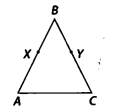
Solution:
Given, AB = BC …(i)
and BX = BY …(ii)
On subtracting (ii) from (i), we get AB – BX = BC – BY
[∵ If equals are subtracted from equals, the remainders are equal]
∴ AX = CY
Question 5.
In the given figure, we have X and Y are the mid-points of AC and BC and AX = CY. Show that AC = BC.

Solution:
We have, X is the mid-point of AC.
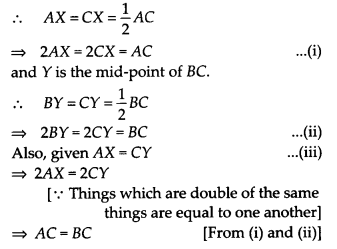
Question 6.
In the given figure, we have
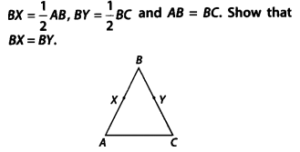
Solution:

Question 7.
In the given figure, we have ∠1 = ∠2 and ∠2 = ∠3. Show that ∠1 = ∠3.
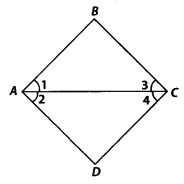
Solution:
We have, ∠1 = ∠2 and ∠2 = ∠3 ⇒ ∠1 = ∠3 [ ∵ Things which are equal to the same thing are equal to one another]
Question 8.
In the given figure, we have ∠1 = ∠3 and ∠2 = ∠4. Show that ∠A = ∠C.
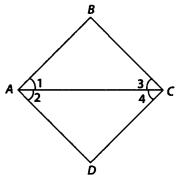
Solution:
Given ∠1 = ∠3 …(i)
∠2 = ∠4 …(ii)
Adding (i) and (ii), we get ∠1 + ∠2 = ∠3 + ∠4
[∵ If equals are added to equals, then wholes are also equal]
⇒ ∠A = ∠C
Question 9.
In the given figure, we have ∠ABC = ∠ACB, ∠3 = ∠4. Show that ∠1 = ∠2.
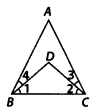
Solution:
Given ∠ABC = ∠ACB …(i)
and ∠A = ∠3 …(ii)
Subtracting (ii) from (i), we get ∠ABC – ∠4 = ∠ACB – ∠3
[ ∵ If equals are subtracted from equals, then remainders are also equal]
⇒ ∠1 = ∠2
Question 10.
In the given figure, we have AC = DC, CB = CE. Show that AB = DE.
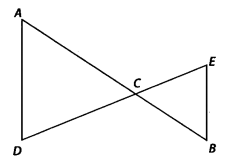
Solution:
We have, AC = DC …(i)
and CB = CE …(ii)
Adding (i) and (ii), we get
AC + CB = DC + CE
[ ∵ If equals are added to equals, then wholes are also equal]
⇒ AB = DE
Question 11.
In the given figure, if OX = 12XY, PX = 12XZ and OX= PX, show that XY= XZ
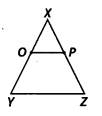
Solution:
Given OX = 12XY ⇒ 20X = XY …(i)
PX = 12XZ ⇒ 2PX = XZ …(ii)
and OX = PX …(iii)
multiplying (iii) by 2, we get
2OX = 2PX
[∵ Things which are double of the same things are equal to one another]
⇒ XY = XZ [From (i) and (ii)]
Question 12.
In the given figure
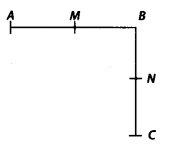
(i) AB = BC, M is the mid-point of AB and N is the mid-point of BC. Show that AM = NC.
(ii) BM = BN, M is the mid-point of AB and N is the mid-point of BC. Show that AB = BC.
Solution:
(i): Given, AB = BC …(1)
M is the mid-point of AB.
![]()
and N is the mid-point of BC.
![]()
Multiplying both sides of (1) by 12, we get
![]()
[ ∵ Things which are halves of the same things are equal to one another]
⇒ AM = NC [Using (2) and (3)]
(ii) Given, BM = BN …(1)
M is the mid-point of AB.
∴ AM = BM = 12AB
⇒ 2AM = 2BM = AB …(2)
and N is the mid-point of BC.
∴ BN = NC = 12BC
⇒ 2BN = 2NC = BC …(3)
multiplying both sides of (1) by 2, we get
2 BM = 2 BN
[ ∵ Things which are double of the same thing are equal to one another]
⇒ AB = BC [Using (2) and (3)]
NCERT Exemplar Class 9 Maths Chapter 5 Exercise 5.4
Question 1.
Read the following statement:
An equilateral triangle is a polygon made up of three line segments out of which two line segments are equal to the third one and all its angles are 60° each.
Define the terms used in this definition which you feel necessary. Are there any undefined terms in this? Can you justify that all sides and all angles are equal in a equilateral triangle.
Solution:
The terms need to be defined are
- Polygon : A closed figure bounded by three or more line Segments.
- Line segment : Part of a line with two end points.
- Line: Undefined term.
- Point: Undefined term.
- Angle: A figure formed by two rays with one common initial point.
- Acute angle : Angle whose measure is between 0° to 90°.
Here undefined terms are line and point.
All the angles of equilateral triangle are 60° each (given).
Two line segments are equal to the third one (given).
“According to Euclid’s axiom, “things which are equal to the same things are equal to one another”, we conclude that all three sides of an equilateral triangle are equal.
Question 2.
Study the following statements:
“Two intersecting lines cannot be perpendicular to the same line.” Check whether it is an equivalent version to the Euclid’s fifth postulate.
[Hint: Identify the two intersecting lines / and m and the line n in the above statement.]
Solution:
Two equivalent versions of Euclid’s fifth postulate are as follows:
(i) For every line l and for every point P not lying on l, there exists a unique line m passing through P and parallel to l.
(ii) Two distinct intersecting lines cannot be parallel to the same line.
From above two statements it is clear that given statement is not an equivalent version to the Euclid’s fifth postulate.
Question 3.
Read the following statements which are taken as axioms:
(i) If a transversal intersects two parallel lines, then corresponding angles are not necessarily equal.
(ii) If a transversal intersect two parallel lines, then alternate interior angles are equal.
Is this system of axioms consistent ? Justify your answer.
Solution:
As we know that, if a transversal intersects two parallel lines, then each pair of corresponding angles are equal, then first is false, so, not an axiom.
Also, if a transversal intersects two parallel lines, then each pair of alternate interior angles are equal, then second is true so, it is an axiom.
So, in given statements, first is false and second is an axiom.
Thus, given system of axioms is not consistent.
Question 4.
Read the following two statements which are taken as axioms:
(i) If two lines intersect each other, then the vertically opposite angles are not equal.
(ii) If a ray stands on a line, then the sum of two adjacent angles, so formed is equal to 180°.
Is this system of axioms consistent ? Justify your answer.
Solution:
As we know that, if two lines intersect each other, then the vertically opposite angles are equal, then first is false, so, not an axiom. Also, if a ray stands on a line, then the sum of two adjacent angles so formed is equal to 180°, then second is true so, it is an axiom.
So, in given statements, first is false and second is an axiom. Thus, given system of axioms is not consistent.
Question 5.
Read the following axioms:
(i) Things which are equal to the same thing are equal to one another.
(ii) If equals are added to equals, the wholes are equal.
(iii) Things which are double of the same thing are equal to one another.
Check whether the given system of axioms is consistent or inconsistent.
Solution:
Since, the given three axioms are Euclid’s axioms.
FAQ’s
Q. How are NCERT Exemplar Solutions for Class 9 Maths Chapter 10 helpful for Class 9 students?
Ans: NCERT Exemplar Solutions for Class 9 Maths Chapter 10 are used by students to get a proper grasp of all the concepts of the subjects and also to lay the foundation for their career or further higher studies. Infinity Learn’s experts formulate these questions in an easy and understandable manner that helps students solve problems in the most efficient possible ways. We hope these solutions will help CBSE Class 9 students to build a strong foundation of the basics and secure excellent marks in their final exam.
Q. Why should we follow NCERT Exemplar Solutions for Class 9 Maths Chapter 10?
Ans: NCERT Exemplar Solutions for Class 9 Maths Chapter 10 is the correct learning strategy that is devised to help them master the concepts. Revising from the solutions, along with the textbooks, will help students crack any problems asked in the second term exams. These solutions help to boost the problem-solving skills of the students, along with their logical reasoning. These are the most popular study materials used by the students to refer for the CBSE term-wise exams. Practicing these solutions help the students to top the final term exams and ace the subject.
Q. Where to download NCERT Exemplar Solutions for Class 9 Maths Chapter 10?
Ans: NCERT Exemplar Solutions for Class 9 Maths Chapter 10 can be downloaded by the students in offline mode or can be referred to online from the Infinity Learn website. These solutions are formulated by Infinity Learn expert faculty, which are present in the NCERT textbook of Class 9 Maths. These are according to the latest term-wise CBSE syllabus.
For more visit NCERT Exemplar Solutions for Class 11 Physics Chapter 9 – Mechanical Properties of Solids









